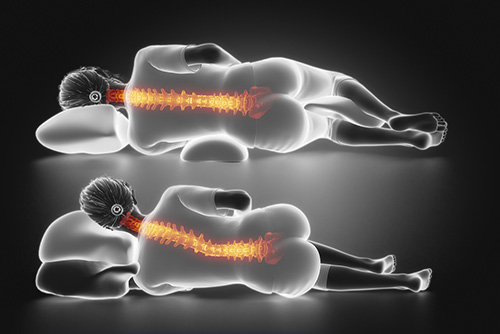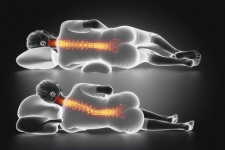On Your Back
When you sleep on your back, your body weight is evenly distributed, and your spine doesn’t have any unnatural curves in it. Putting a small pillow under your head and neck will elevate your head slightly and can help your spine stay in a neutral position.

If you snore, you should know that sleeping on your back might make you more likely to snore. And if you have sleep apnea, which causes you to stop breathing for periods during the night, this position could cause your tongue to block your airway. However, this is still the best sleeping position for most people.
On Your Side
This is a popular sleep position — 15 percent of adults sleep on their side. This position can be better than sleeping on your back because you aren’t as likely to snore when you’re sleeping on your side. If you put a small pillow between your knees, then your spine, pelvis, and hips will also be aligned. Putting a pillow under your head will form a straight line down through your spine.
Older people might notice a disadvantage of this position. Because you’re pressing your face into the pillow, you might get more wrinkles and see your skin sagging.
Avoid: Fetal Position
When you sleep with your legs curled to your chest and your chin tucked in, you may find yourself a bit stiff in the morning, especially if you have arthritis. Even if you don’t have arthritis, it might make your back hurt when you wake up in the morning.
This position can also restrict your breathing if you’re curled up too tightly. Unfortunately, this is also the most common sleep position, with 41 percent of adults choosing it.
The fetal position can work for some people, however. If you’re pregnant, sleeping in this position on your left side can improve circulation for you and your baby. Sleeping on your left side prevents the baby from pressing on your liver on your right side.
If you find yourself sleeping in this position a lot, try uncurling your body a bit to straighten out your spine. Using a plump pillow can support your head and neck.
Definitely Avoid: Stomach Position
When you sleep on your stomach, your neck and spine aren’t in a neutral position, and your spine isn’t properly aligned. Since your body weight isn’t evenly distributed, you’re putting unnecessary pressure on your joints and nerves. This can lead to numbness and tingling from nerve pressure. You might also wake up with a stiff neck because you have to sleep with your head turned to the side.
If you’re a stomach sleeper, it’s best to try to break the habit. But if you can’t, you can place a pillow under your forehead. This will allow you to breathe while still keeping your head and spine aligned.
There are many other sleep positions, too, and if you’re not sure you’ve chosen the right one, check to see if your head, neck, spine, and pelvis are straight. If so, you can rest assured that your spine will stay healthy.

